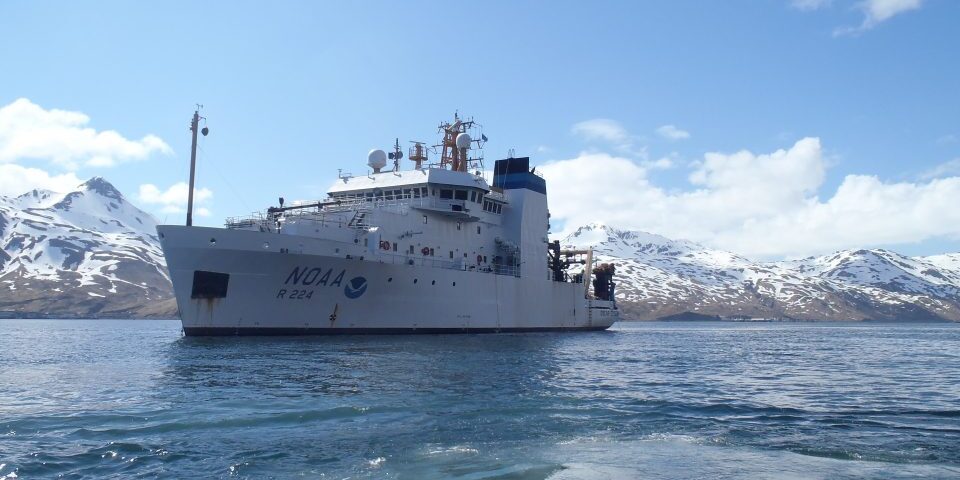NOAA and EcoFOCI sent out one of few research cruises around the Bering Strait earlier this season. The cruise brought back information on the cold pool and marine mammals’ movements in the Bering Sea.
EcoFOCI planned on sending out seven research cruises in 2020. That number dwindled to five, and finally down to one cruise as a result of COVID-19. The lone vessel Oscar Dyson set out in late August with a crew of three researchers to find data on the cold pool and various marine mammals in the Northern Bering Sea.
“In the beginning, basically everyone didn’t think we would get everything done, but about halfway through we were realizing that we were going to get pretty much everything done and it built in momentum and everyone was really excited.”
– Catherine Berchok, Accoustician
Catherine Berchok is the head of the Passive Acoustic Group at Alaska Fisheries Science Center Marine Mammal Lab, and one of the three researchers on the cruise.
Phyllis Stabeno of EcoFOCI recently shared the preliminary findings of the Dyson crew in a Strait Science presentation last month and talked about the struggles the ship had with leaving port.
Due to Covid-19, the cruise looked quite different from previous research expeditions in the region. EcoFOCI usually has two separate cruises in the region – one for the Bering Sea and one for the Arctic. Because NOAA was only able to send out one cruise, they combined these two separate expeditions into one.
And while research cruises like this usually have crews of 15 people, EcoFOCI had to slim down to 9 people onboard to comply with social distancing guidelines. However, Stabeno says that plan was also rearranged.
“We were only going to have nine people on the vessel. And to our immense horror one person tested positive for the coronavirus, and five other people had been exposed or in contact, so in the end, instead of nine people on a cruise that we need 15 people on, three people went to sea.”
– Phyllis Stabeno
Stabeno says that the data collected was impressive for a crew so small. Much of the data is still being analyzed, but Stabeno was able to share the preliminary findings from the Dyson crew on the cold pool in early October.
“And this is preliminary results, the formal analysis hasn’t been done yet. But the preliminary analysis has [been done]. It was an average cold pool this year.”
– Phyllis Stabeno
The team located the cold pool in the Northwestern Bering Sea, near the Russian coast. Ocean temperatures in the Northern Bering Sea seem to be a bit colder in 2020 than in 2019, but Stabeno says the high sea surface temperatures of last year have persisted into this year.
“We had a relatively strong, above average, sea ice extent. But there’s been a lot of heat. 2019 was very warm temperatures in the southern Bering Sea, and those warm temperatures persevered, so we continue to have warm temperatures in the south. In the north, the ice came in and cooled the water column and you ended up with very cold temperatures.”
– Phyllis Stabeno
Although it is too soon to understand the findings on marine mammals from the Dyson, Stabeno presented on Berchok’s acoustic findings on whales from 2019. Bowhead whales usually do not remain in the Chukchi Sea when the ice comes down. However, because of thin and limited ice, bowheads have overwintered in the Chukchi in recent years. Berchok notes that other species, like humpback and gray whales, are also changing migration patterns.
“We are definitely noticing a change in Arctic species to where they’re not staying all the time in the Northern Bering but they’re moving up into the Southern Chukchi all winter long.
– Catherine Berchok
With COVID-19 persisting across Western Alaska and the state, EcoFOCI needs to prepare for another year of monitoring the Bering Sea cold pool with minimal research cruises. Stabeno says the immediate solution is to implement better technology, and to find ways to work with local communities and ships to help deploy pop-up buoys.
“This particular design was the idea that we really want to be able to deploy these types of instruments without having to use a research vessel, you know, to partner with the fishing industry, local communities, etc. to help monitor what’s happening in the Bering Sea and also in the Chukchi.”
– Phyllis Stabeno, NOAA EcoFOCI
Bottom-moored echo sounders are also planned on being deployed to monitor activity from marine life in the Bering Sea cold pool.
The final analysis of all the data collected on the Dyson will begin to be released within the next couple of months.
Image at top: NOAA ship Oscar Dyson near Dutch Harbor, Alaska. Photo courtesy of NOAA (2020).




